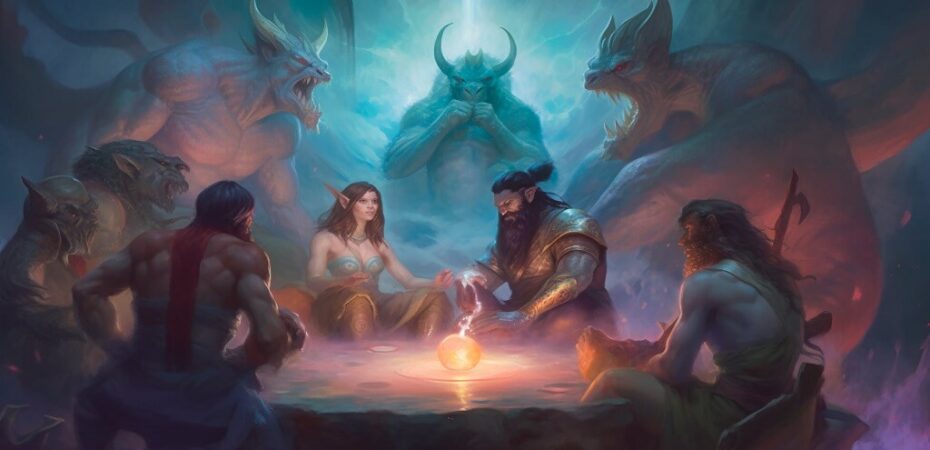The D&D universe’s gods and goddesses are powerful but flawed entities with great power. There are many God of Dragons, and the majority of them are specific to each setting, which means that a distinct pantheon of gods will have to be honored in Faerun than in Krynn. There are certain caveats with multiversal travel allowed, and non-human deities’ gods can be uniform across different settings, as they are in the Shar Forgotten Realms or Greyhawk.
Religion is vital to the D&D universe’s inhabitants. In a world full of perils, having the power to petition a deity provides hope and, occasionally, the blessings of a specific boon or other to reward their devotion. Those who devote themselves towards the worship of one or more gods, such as clerics and paladins, have the potential to bestow enormous power on their followers. In exceedingly unusual cases, some people may face off with the gods themselves. While the D&D Gods are immortals, they aren’t invincible and can be slain or vanquished in rare circumstances, such as when gods trod the Toril as mortal avatars during the Time of Troubles in Faerun.
Some mortals aspire to godhood, and some, like Vecna and Kelemvor, have achieved this incredible feat. Such people are listed below, but this opens up a lot of room for DMs to make their own divinities or even give players a chance to become gods themselves.
There could be gods within the universe that the majority have never heard of.
The Forgotten Realms Gods
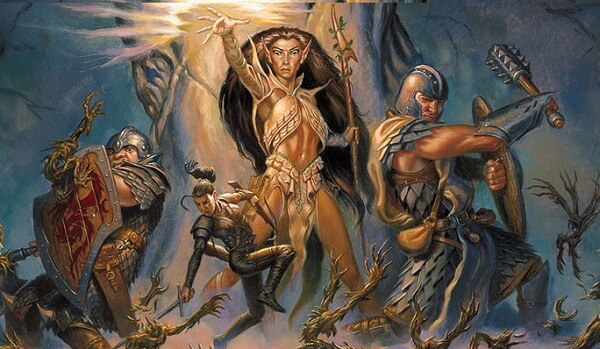
Toril was founded by the twin deities Shar and Selune. Each goddess balanced the other and collaborated to construct the worlds of the Forgotten Realms. Selune provided the illumination, while Shar gave the shadowy areas. They also created Chauntea, who gave their planet life but asked for warmth so that her living things could survive. A tremendous schism developed between the two goddesses at this juncture, resulting in a fight. The list of DnD 5e Gods of the Forgotten Realms has grown since its inception, with every one of the d&d deities of the Forgotten Realms mentioned below:
| Name | Symbol | Domain | Alignment | Gender |
| Auril | Snowflake with points | Winter | Neutral Evil | Female |
| Azuth | Left hand, outlined in fire, pointing upwards | Wizards | Lawful Neutral | Male |
| Bane | right hand fist in black | Tyranny | Lawful Evil | Male |
| Beshaba | Pair of antlers in black | Misfortune | Chaotic Evil | Female |
| Bhaal | Skull, red glowing eyes, surrounded by drops of blood | Murder | Neutral Evil | Male |
| Chauntea | Grain sheaf | Agriculture | Neutral Good | Female |
| Cyric | white skull, jawless, on purple | Lies | Chaotic Evil | Male |
| Deneir | An open eye with a lit candle above | Writing | Neutral Good | Male |
| Eldath | Waterfall descending into a pool | Peace | Neutral Good | Female |
| Gond | 4 spoked cog | Craft | True Neutral | Male |
| Helm | Gauntlet with an eye | Protection | Lawful Neutral | Male |
| Ilmater | 2 hands tied by a red cord | Endurance | Lawful Good | Male |
| Kelemvor | Skeletal arm bearing scales that are balanced | The Dead | Lawful Neutral | Male |
| Lathander | The road leading into the sunset | Birth and Renewal | Neutral good | Male |
| Liera | Inverted triangle with whirling mist | Illusion | Chaotic Neutral | Female |
| Lliira | three 6-pointed stars | Joy | Chaotic Good | Female |
| Loviatar | scourge with 9 barbed tails | Pain | Lawful Evil | Female |
| Malar | A paw with claws | The Hunt | Chaotic Evil | Male |
| Mask | A mask in black | Thieves | Chaotic Neutral | Male |
| Mielikki | Head of a unicorn’s | Forests | Neutral Good | Female |
| Myrkul | Human skull in white | Death | Neutral Evil | Male |
| Mystra | Flowing red mist surrounded by 7 stars | Magic | Neutral Good | Female |
| Oghma | Empty scroll | Knowledge | True Neutral | Male |
| Savras | Crystal ball with multiple eyes | Divination and Fate | Lawful Neutral | Male |
| Selune | 7 stars surrounding a pair of eyes | Moon | Chaotic Good | Female |
| Shar | Disc in black with a purple border | Darkness and Loss | Neutral Evil | Female |
| Silvanus | Oak leaf | Wild Nature | True Neutral | Male |
| Sune | Face of a beautiful redhead woman | Love and Beauty | Chaotic Good | Female |
| Talona | Triangle with 3 tear drops | Disease and Poison | Chaotic Evil | Female |
| Talos | A trio lightning bolts | Storms | Chaotic Evil | Male |
| Tempus | Flaming sword pointing upwards | War | True Neutral | Male |
| Torm | Right gauntlet in white | Courage and Self-Sacrifice | Lawful Good | Male |
| Tymora | Silver coin with a face surrounded by a shamrock | Good Fortune and Adventure | Chaotic Good | Female |
| Tyr | A warhammer with balanced scales | Justice and Heroism | Lawful Good | Male |
| Umberlee | Ocean wave | Sea | Chaotic Evil | Female |
| Waukeen | Waukeen’s profile on a coin | Trade | True Neutral | Female |
Gods of Dragonlance
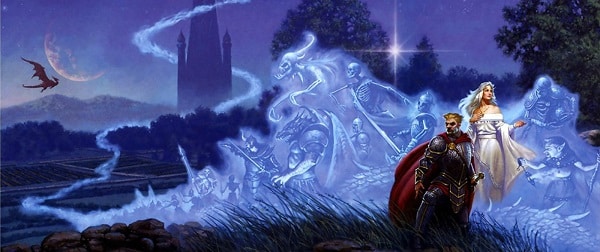
Three fundamental deities are called the High Gods in Dragonlance, each representing a different alignment: Paladine for favorable, Gilean for neutrality, and Takhisi for evil. Each one of the deities has built alliances with other gods that share their beliefs. Each group has a deity of magic who grants magical powers suited to their alignment; Solinari grants good magic, Lunitari grants neutral magic, and Nuitari grants evil magic. Chaos, a god that wishes to destroy all of Krynn, opposes all of these gods.
The following are all the gods from the Dragonlance setting:
| Name | Symbol | Domain | Alignment | Gender |
| Paladine | Silver triangle | Rulers and Guardians | Lawful Good | Male |
| Branchala | Harp | Music | Neutral Good | Male |
| Habbakuk | Blue bird | Animal Life and the Sea | Neutral Good | Male |
| Kiri-Jolith | Pair of bison horns | Honour and War | Lawful Good | Male |
| Majere | Copper spider | Meditation and Order | Lawful Good | Male |
| Mishakal | Blue infinity symbol | Healing | Lawful Good | Female |
| Solinari | White circle | Good Magic | Lawful Good | Female |
| Gilean | Open Book | Knowledge | True Neutral | Male |
| Chislev | Feather | Nature | True Neutral | Female |
| Reorx | Forging hammer | Craft | True Neutral | Male |
| Shinare | Griffon’s wing | Wealth and Trade | True Neutral | Female |
| Sirrion | Multi-coloured fire | Fire and Change | True Neutral | Male |
| Zivilyn | Green or gold tree | Wisdom | True Neutral | Male |
| Lunitari | Red circle | Neutral Magic | True Neutral | Female |
| Takhisis | Black crescent | Night and Hatred | Lawful Evil | Female |
| Chemosh | Yellow skull | Undead | Lawful Evil | Male |
| Hiddukel | Broken merchant’s scales | Lies and Greed | Chaotic Evil | Male |
| Morgion | 2 red eyes under a hood | Disease and Secrecy | Neutral Evil | Male |
| Sargonnas | Flying red condor | Vengeance and Fire | Lawful Evil | Male |
| Zeboim | Turtle shell | Sea and Storms | Chaotic Evil | Female |
| Nuitari | Black circle | Evil Magic | Lawful Evil | Male |
Gods of Greyhawk
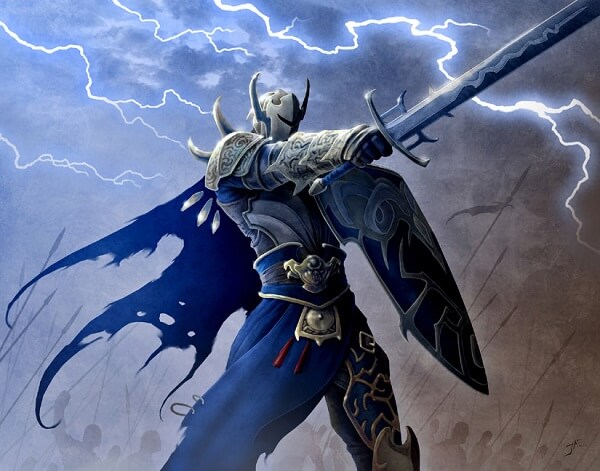
The inhabitants of Oerth (the principal planet in Greyhawk’s setting) worship over a hundred deities. Most of these vary among races, but the majority can be divided into many sub-pantheons according to the kinds of people who worship them:
- Olman
- Oeridian
- Flan
- Baklunish
- Suel
- Touv
- Non-Human Deities
- Monstrous Deities
The main, human deities of Greyhawk are listed below:
| Name | Symbol | Domain | Alignment | Gender |
| Beory | Green disc | Nature | True Neutral | Female |
| Boccob | A pentagram with an eye | Magic | True Neutral | Male |
| Celestian | 7 star arc in a circle | Stars and Wanderers | True Neutral | Male |
| Ehlonna | Horn of a unicorn | Woodlands | Neutral Good | Female |
| Erythnul | Blood drop | Envy and Slaughter | Chaotic Evil | Male |
| Fharlanghn | Circle with a curved horizontal line and arc | Horizons and Exploration | Neutral Good | Male |
| Heironeous | Blot of lightning | Chivalry and War | Lawful Good | Male |
| Hextor | 6 down facing arrows | War and Discord | Lawful Good | Male |
| Kord | 4 spears and maces | Athletics and Sport | Chaotic Good | Male |
| Incabulos | A diamond-encrusted reptilian eye | Plague and Famine | Neutral Evil | Male |
| Istus | Spindle with 3 strands | Fate and Destiny | True Neutral | Female |
| Luz | Human skull with a grin | Pain and Oppression | Chaotic Evil | Male |
| Nerull | Skull with scythe or sickle | Death | Neutral Evil | Male |
| Obad-Hai | Acorn or oak leaf | Nature | True Neutral | Male |
| Olidammara | Mask with laughter expression | Revalry | Chaotic Neutral | Male |
| Pelor | The Sun | Sun and Healing | Neutral Good | Male |
| Pholtus | A full moon or silver sun is obscured by a smaller crescent moon. | Light and Law | Lawful Good | Male |
| Ralishaz | Three fate casting bones | Poor Luck and Insanity | Chaotic Neutral | Male |
| Rao | White heart | Peace and Reason | Lawful Good | Male |
| Saint Cuthbert | Starburst lines encircling a circle | Common Sense and Zeal | Lawful Neutral | Male |
| Tharizdun | Inverted ziggurat or dark spiral | Eternal Darkness | Chaotic Evil | Male |
| Trithereon | Triskelion | Liberty and Retribution | Lawful Good | Male |
| Ulaa | A circle surrounded by a mountain | Hills and Mountains | Lawful Good | Female |
| Vecna | A palm with an eye in it | Evil Secrets | Neutral Evil | Male |
| Wee jas | Red skull with a fireball in the back | Magic and Death | Lawful Neutral | Female |
Eberron Gods
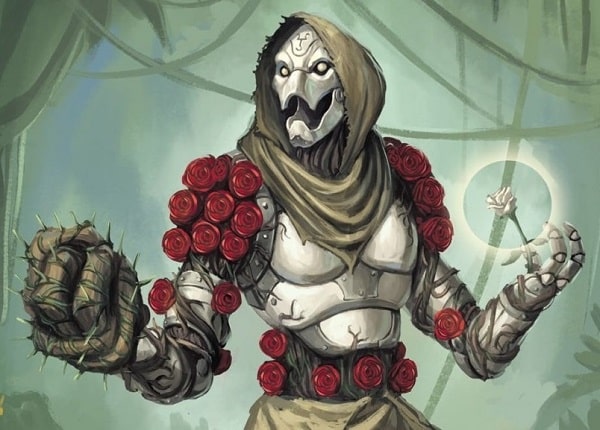
The world of Eberron holds a distinct perspective on gods: you don’t know if they exist or if the effects caused by Clerics are a different kind of magic. Eberron has a creation narrative about three dragons–Siberys, Eberron, and Khyber–creating the planes until Khyber revolted against the others. Siberys were killed, and their remains formed the ring of ‘dragon shards’ that circled the planet. Eberron confronted Khyber but couldn’t defeat her. Instead, he created a living cage to contain her, constructing the world around the treacherous dragon, giving us the planet and its name in the process.
This creation narrative does not leave the people of Eberron with any deities to worship; therefore, who do they worship? It changes, but the makeup of the world allows some people to worship gods who do not appear in the world. Others adhere to philosophies or are atheists who do not believe in any sort of gods because there is no solid proof of their existence other than manifestations of the faithful’s willpower.
Here are a few instances of what you might believe in or follow in Eberron:
The Sovereign Host Gods
- Arawai – Goddess of fertility, Neutral Good
- Aureon – God of law and knowledge, Neutral lawful
- Dol Dorn – God of strength at arms, Chaotic Good
- Onatar – God of craft, Neutral Good
- Balinor – God of beasts and the hunt, Neutral
- Boldrei – Goddess of community and home, Lawful Good
- Kol Korran – God of trade and wealth, Neutral
- Ollandra – Goddess of good fortune, Neutral Good
- Dol Arrah – Goddess of sunlight and honor, Lawful Good
The Dark Six God
- The Devourer – God of nature’s wrath, Neutral Evil
- The Traveler – Deity of chaos and change Chaotic Neutral
- The Keeper – God of greed and death, Neutral Evil
- The Fury – Goddess of wrath and madness, Neutral Evil
- The Shadow – God of dark magic, Chaotic Evil
- The Mockery – God of violence and betrayal, Neutral Evil
Other Faith Gods
- Cults of the Dragon Below – Deities of madness, Neutral Evil
- The Undying Court – Elven ancestors, Neutral Good
- The Silver Flame – Deity of protection and good, Lawful Good
- The Blood of Vol – Philosophy of immortality and undeath, Lawful Neutral
- The Spirits of the Past – Elven ancestors, Chaotic Good
- The Path of Light – Philosophy of light and self-improvement, Lawful Neutral
Gods of Dark Sun
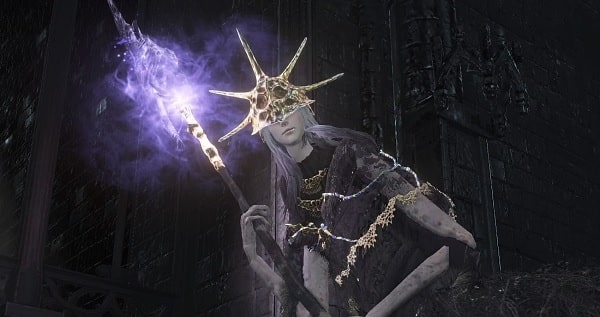
Dark Sun is distinctive among D&D settings in that no Gods of D&D have been established to act within it. Some think that the deities were merely unable to enter the material dimension, similar to other beings from Dark Sun’s outer planes. Others say the primordials overcame the gods, preventing or compelling them to escape Athas. In any case, there are no active gods in the Dark Sun setting, which means there are zero clerics, paladins, or other DnD faiths apart from those that get no power through their gods.
Gods of Ravenloft
There are no gods in Ravenloft, strictly speaking, but there are god-like beings who govern over Ravenloft plus its Domains of Dread, identified only as the Dark powers. They are dark and terrible beings who are enigmatic and inscrutable. They created the Domains of Dread, turning them into real nightmares for the residents, and they dragged individuals from the mortal realms to Ravenloft, trapping them behind the hazy confines of any domain they chose.
Pantheons 5e
The pantheons of Celtic, Egyptian, Greek, and Norse mythology are imaginative interpretations of historical faiths from our world’s past. They include deities that have been separated from their historical context in the real world and unified into pantheons that fulfill the purposes of the game.
The SRD for Wizard of the Coast has Fantasy Pantheons.
Celtic Gods & Deities 5e
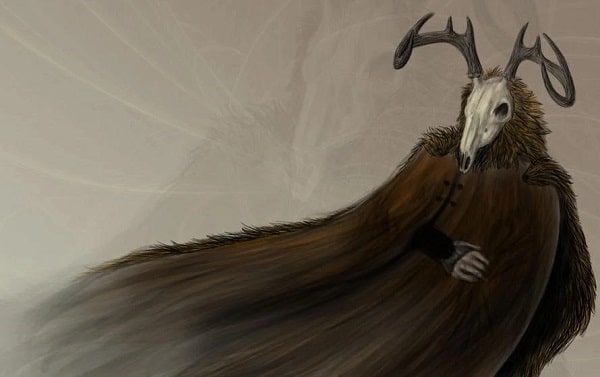
Something wild is supposed to hide in the core of every soul, a place that responds to hear the sound of geese at night, the whispering wind among the pines, the unexpected scarlet of mistletoe on an oak–and it is in this void that the Celtic gods live. They arose from the stream and brook, their power amplified by the oak’s strength and the splendor of the woodlands as well as the moor. These gods came into being when the first forester dared to name the visage seen in the bole of a tree or the voice babbling in a creek.
Druids and clerics both serve the Celtic gods, as they are closely associated with the natural elements that druids revere.
| Deity | Symbol | Suggested Domains | Alignment |
| The Daghdha, god of weather and crops | Shield or cauldron with something bubbling inside | Nature, Trickery | CG |
| Arawn, god of life and death | Gray background with a black star | Life, Death | NE |
| Belenus, god of sun, light, and warmth | Standing stones and solar disk | Light | NG |
| Brigantia, goddess of rivers and livestock | Footbridge | Life | NG |
| Diancecht, god of Medicine and Healing | mistletoe berries and leaf | Life | LG |
| Dunatis, god of mountains and peaks | Mountain peak with a red sun on top | Nature | N |
| Goibhniu, god of smiths and Healing | Sword under a large mallet | Knowledge, Life | NG |
| Lugh, god of arts, Travel, and Commerce | Long hands | Knowledge, Life | CN |
| Manannan mac Lir, god of oceans and sea Creatures | White waves on a green background | Nature, Tempest | LN |
| Math Mathonwy, god of magic | Staff | Knowledge | NE |
| Morrigan, goddess of battle | Two spears, crossed | War | CE |
| Nuada, god of war and warriors | Black background with a silver hand | War | N |
| Oghma, god of Speech and writing | Scroll that is unfurled | Knowledge | NG |
| Silvanus god of Nature and Forests | Oak tree in Summer | Nature | N |
Greek Gods & Deities 5e

The gods of Olympus manifest themselves through the gentle lap of waves upon the coasts and the crack of thunder among the cloud-engulfed heights. The deep boar-infested woods with the barren, olive-covered hillsides bear witness to their demise. Every facet of nature echoes from their presence, and they’ve created a home inside the human heart as well.
| Deity | Symbol | Suggested Domains | Alignment |
| Zeus, god of The Sky, ruler of the gods | Lightning bolts held in a fist | Tempest | N |
| Aphrodite, goddess of love and beauty | Sea shell | Light | CG |
| Apollo, god of light, music, and Healing | Lyr | Knowledge, Life, Light | CG |
| Ares, god of war and strife | Spear | War | CE |
| Artemis, goddess of hunting and childbirth | Lunar disk with bow and arrow | Life, Nature | NG |
| Athena, goddess of Wisdom and civilization | Owl | Knowledge, War | LG |
| Demeter, goddess of agriculture | Head of a Mare | Life | NG |
| Dionysus, god of mirth and wine | Thyrsus (staff with pine cone tip) | Life | CN |
| Hades, god of The Underworld | Black ram | Death | LE |
| Hecate, goddess of magic and the moon | Setting moon | Knowledge, Trickery | CE |
| Hephaestus, god of smithing and craft | Anvil and hammer | Knowledge | NG |
| Hera, goddess of marriage and Intrigue | Fan made of peacock feathers | Trickery | CN |
| Hercules, god of Strength and adventure | Head of a lion | Tempest, War | CG |
| Hermes, god of Travel and Commerce | Caduceus (staff with wings and serpents) | Trickery | CG |
| Hestia, goddess of home and Family | Hearth | Life | NG |
| Nike, goddess of victory | Woman with wings | War | LN |
| Pan, god of Nature | Syrinx (pan pipes) | Nature | CN |
| Poseidon, god of The Sea and Earthquakes | Trident | Tempest | CN |
| Tyche, goddess of good fortune | Pentagram in red | Trickery | N |
Egyptian Gods & Deities 5e
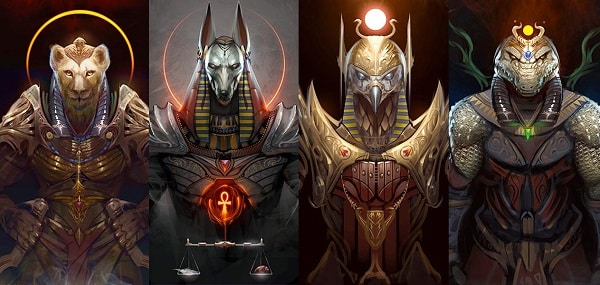
These gods are the heirs of an ancient divine family, heirs to the cosmos’ rulership and the preservation of the sacred principle of Ma’at–the fundamental order of justice, truth, law, and order that places deities, mortal pharaohs, and regular men and women into their logical and rightful place in the universe.
The Egyptian DnD pantheon is unique in that it had three gods of death, each with a different alignment. Anubis is a lawful neutral afterlife god who assesses the souls of the dead. Set is a chaotic evil deity of murder, most famous for assassinating his brother Osiris. At the same time, Nephthys is a chaotic mourning goddess.
| Deity | Symbol | Suggested Domains | Alignment |
| Re-Horakhty, god of the sun, ruler of the gods | Solar disk surrounded by a serpent | Life, Light | LG |
| Anubis, god of judgment and death | Black Jackal | Death | LN |
| Apep, god of evil, fire, and serpents | Snake with flames | Trickery | NE |
| Bast, goddess of cats and vengeance | Cat | War | CG |
| Bes, god of luck and music | Deformed deity | Trickery | CN |
| Hathor, goddess of love, music, and motherhood | Horned head of a cow with lunar disk | Life, Light | NG |
| Imhotep, god of crafts and Medicine | Steppped pyramid | Knowledge | NG |
| Isis, goddess of fertility and magic | Star and Ankh | Knowledge, Life | NG |
| Nephthys, goddess of death and grief | Lunar disk surrounded by horns | Death | CG |
| Osiris, god of Nature and The Underworld | Flail and crook | Life, Nature | LG |
| Ptah, god of crafts, knowledge, and Secrets | Bull | Knowledge | LN |
| Set, god of Darkness and Desert storms | Coiled cobra | Death, Tempest, Trickery | CE |
| Sobek, god of water and crocodiles | Horned Crocodile with plumes | Nature, Tempest | LE |
| Thoth, god of knowledge and Wisdom | Ibis | Knowledge | N |
Norse Gods & Deities 5e
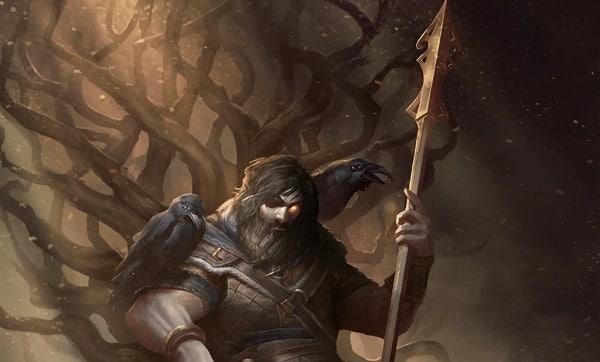
The realm of the Vikings, the home of the Norse pantheon, is where the land plummets from the snowy slopes into the freezing fjords below, where longboats draw up on the beach, and where glaciers flow forward and retreat with every fall and spring.
It’s a harsh environment that necessitates difficult existence. The region’s warriors must have adjusted to severe settings to exist, yet their surroundings have not twisted them. Considering the necessity of plundering for food and money, it’s remarkable that the mortals fared so well.
Their abilities reflect the soldiers’ need for solid leadership along with decisive action. As a result, people may see their deities in every river bend, hear them in the bang of thunder and the roaring of glaciers, and smell them in the black smoke emanating from a burning longhouse.
The Aesir (gods of war and fate) with the Vanir (fertility and wealth gods) are the two principal families in the Norse pantheon. These two families, once enemies, are now closely linked against their familiar foes, giants in particular (which include the deities Surtur and Thrym).
| Deity | Symbol | Suggested Domains | Alignment |
| Odin, god of knowledge and war | Blue eye that watches | Knowledge, War | NG |
| Aegir, god of The Sea and storms | Rough oceanic waves | Tempest | NE |
| Balder, god of beauty and poetry | Silver chalice encrusted with gems | Life, Light | NG |
| Forseti, god of justice and law | Bearded man’s Head | Light | N |
| Frey, god of fertility and the sun | Greatsword in ice blue color | Life, Light | NG |
| Freya, goddess of fertility and love | Falcon | Life | NG |
| Frigga, goddess of birth and fertility | Cat | Life, Light | N |
| Heimdall, god of watchfulness and loyalty | Curling music horn | Light, War | LG |
| Hel, goddess of The Underworld | Partially rotting woman’s face | Death | NE |
| Hermod, god of luck | Scroll with wings | Trickery | CN |
| Loki, god of thieves and trickery | Flame | Trickery | CE |
| Njord, god of sea and wind | Gold coin | Nature, Tempest | NG |
| Odur, god of light and the sun | Solar disk | Light | CG |
| Sif, goddess of war | Sword raised up | War | CG |
| Skadi, god of earth and mountains | Peak of a mountain peak | Nature | N |
| Surtur, god of fire Giants and war | Sword with flames | War | LE |
| Thor, god of storms and thunder | Hammer | Tempest, War | CG |
| Thrym, god of frost Giants and cold | Double-bladed ax in white | War | CE |
| Tyr, god of courage and strategy | Sword | Knowledge, War | LN |
| Uller, god of hunting and winter | Longbow | Nature | CN |
Patron Gods & Deities 5e

Patrons are gods who bestow magical abilities on individuals. They are also referred to as Non-Human Deities. Their spellcasting abilities, along with magical powers, are inherited from their customers. Clerics and Paladins adore them, while Warlocks form alliances with them.
Below are some alternatives to consider for your Paladin’s Patron god or Cleric, as well as some ideas for a future Warlock Patron.
| Deity | Symbol | Suggested Domains | Alignment | Reviewsed Notes |
| Bahamut, Dragon God of Good | Dragon’s head in profile | Life, Protection, War | LG | Bahamut is an excellent pick for Dragonborn and characters of “good” alignment. |
| Blibdoolpoolp, Kuo-toa Goddess | Lobster head or black pearl | Death | NE | Because of their inclination for madness and the water, they make excellent Old One patrons or Undead. |
| Corellon Larethian, Elf Deity of Art and Magic | Quarter moon or starburst | Arcana,Light | CG | This is an excellent choice for elven Clerics or Paladins. He was a superb swordsman, so he’s a fantastic pick if you wish to use a sword as the main weapon. |
| Deep Sashelas, Elf God of the Sea | Dolphin | Nature, Tempest | CG | He’s the D&D god’s counterpart of Aquaman. If you’re planning a water-based activity, this is a great option. |
| Eadro, Merfolk Deity of the Sea | Spiral design | Nature, Tempest | N | Eadro created the Locathah and Merfolk, therefore including them in a campaign is necessary when they are involved. |
| Garl Glittergold, Gnome God of Trickery and Wiles | Gold nugget | Trickery | LG | Garl Glittergold is a trickster-type god and the generic god of gnomes. |
| Grolantor, Hill Giant God of War | Wooden club | War | CE | Grolantor’s main characteristic is that he despises races smaller than him and advocates violence against them. That is why hill giants revere him. |
| Gruumsh, Orc God of Storms and War | Unblinking eye | Tempest, War | CE | Gruumsh is the Orc god. This deity with a single eye is thought to keep an eye on all Orcs until they take over the globe. |
| Hruggek, Bugbear God of Violence | Morningstar | War | CE | Hruggek is the ambush god. This is consistent with Bugbear tactics. |
| Kurtulmak, Kobold God of War and Mining | Gnome skull | War | LE | Kurtulmak, the craftiest Kobold, is their chief god and works for the betterment of all Kobolds. |
| Laogzed, Troglodyte God of Hunger | Image of the lizard/toad god | Death | CE | It is additionally recognized as the soul eater and has an insatiable appetite. Laogzed is another excellent Elder God patron. |
| Lolth, Drow Goddess of Spiders | Spider | Trickery | CE | The Drow worship spiders, and Lolth is their principal deity. |
| Maglubiyet, Goblinoid God of War | Bloody axe | Order,War | LE | Maglubiyet worshippers frequently massacred their enemies as well as innocents for the sake of Maglubiyet. |
| Moradin, Dwarf God of Creation | Hammer and anvil | Forge,Knowledge | LG(Lawful Evil) | He was one of the Dwarves’ primary gods and was also known as the Soul Forger. |
| Rillifane Rallathil, Wood Elf God of Nature | Oak | Nature | CG | Rillifane is among the forest gods and the defender of nature. |
| Sehanine Moonbow, Elf Goddess of the Moon | Crescent moon | Knowledge | CG | Sehanine also had strong ties to the fey, making her an ideal Fey patron to Warlocks. |
| Sekolah, god of the hunt | Shark | Nature, Tempest | LE | Sekolah is the Sahugin’s shark deity, also called “He Who Eats.” |
| Semuanya, Lizardfolk Deity of Survival | Egg | Life | N | Semuanya is considered the god of survival, and his devotees can often be found alone in the wilderness. |
| Skerrit, Centaur and Satyr God of Nature | Oak growing from acorn | Nature | N | Skerrit, likewise referred to as the Forest Walker, roams the country, preserving the woodlands that fall within his realm. |
| Skoraeus Stonebones, God of Stone Giants and Art | Stalactite | Knowledge | N | Skoraeus is the stone giants’ defender. He was a recluse who only set out to guide the Stone Giants’ journey. |
| Surtur, God of Fire Giants and Craft | Flaming sword | Knowledge, War | LE | Surtur is the god of the Fire Giants, and his temples are gigantic forges where the giants honed their skills. |
| Thrym, God of Frost Giants and Strength | White double-bladed ax | War | CE(Chaotic Evil) | Thrym is the fourth deity of the giant pantheon, and he is the leader of the Frost Giants. |
| Tiamat, Dragon Goddess of Evil | Dragon head with five claw marks | Trickery | LE | Tiamat is Bahamut’s sister and the malevolent queen of dragons. |
| Yondalla, Halfling Goddess of Fertility and Protection | Shield | Life, Protection | Yondalla created the deity of the Halflings. |
5e Deities FAQs (Frequently Asked Questions)
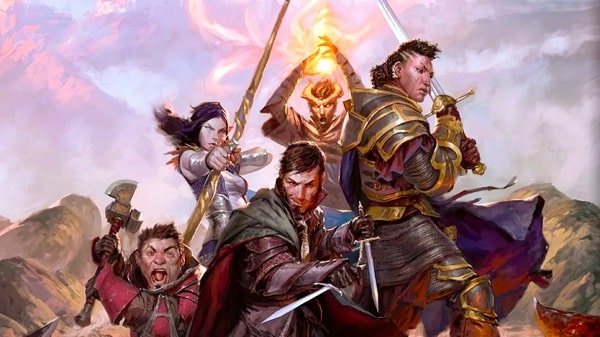
In D&D, how does one go about killing a god?
The quick answer is no unless it is the plot of the story. Earlier editions of D&D gave the gods and goddesses distinct stat blocks and powers, but they’re currently within an amorphous weight class basically labeled “stronger than you” at the moment. Gods aren’t unkillable in 5e, but throughout the majority of the lore, gods are often destroyed by other deities or demon lords. There is no “magic bullet” established in the lore, and gods are killed through regular old fighting, albeit on a mythological scale.
If your adventure appears to be leading up to a battle with a deity D&D, expect some complicated circumstances or a God-slaying mcguffin because otherwise, any deity would be able to sweep the ground with even level 20 adventurers.
In D&D, what number of gods are there?
This is a complex question, but let’s simplify it by assuming 5th edition D&D, excluding real-world pantheons such as the Greek and Norse pantheons, and using the Forgotten Realms setting. There’s some discussion about whether a few should be considered deities, but according to my count, D&D presently has 61 gods.
How to create a god in D&D?
This is reasonably simple in 5th edition D&D because there isn’t much to do mechanically. You’ll be adding a deity to the d&d pantheon in no time!
To begin, don’t be concerned about creating stats for the god. Gods are in the ethereal category of “very powerful,” and no one should expect to fight a deity in the 5th edition unless their dungeon master is exceptionally lenient.
The first thing you should do is research your lore. Because almost little of what happens here will be of any mechanical significance, focus on how they relate to your world. What is this deity concerned with? Do they genuinely care about their followers, or were they only pawns to be used? What are their followers’ reactions to or interpretations of their teachings? How are their houses of worship? What sort of objects and traditions do their adherents keep? Are they enormous golden declarations of the god’s majesty, or are they simply wayside markings and shrines? Is this god related to any particular creatures? Such as ravens and spiders. What does their sacred emblem resemble? Gods are frequently linked to the world-building of a setting, and although we could go on and on about world-building, simply attempt to find out this deity’s function in your world.
Understanding all of the minor components that comprise D&D religions will assist you in creating a supreme being that fits neatly within the pantheon.
As soon as you have lore, you only need to lock down a few minor aspects for the players to deal with: Name, Domains, Alignment, and Symbol are all options.
You need to have the name, but if you’re going to list it out for the players, you’ll want their full title.
Thematically, the Alignment is vital so your players can instantly understand your deity’s disposition. Although it is no longer as crucial as in previous editions, make sure to specify an alignment that represents your god.
The Domains are most likely the most essential mechanical component. Many of the skills and attributes of the clerics that serve your new deity will be determined by these realms. Many deities possess just a single domain, but two or three domains are permitted if your god is truly situated amongst numerous domains.
Finally, each dd god should possess a Symbol, which can be anything, but the simpler, the better. For example, a green flaming eye makes it simpler to work with as well as remember versus nine jade eyes encompassed by rainbow fires with a jumping two-headed liger. You can also make your god’s insignia a specific sort of weapon, adding character for clerics or paladins using their god’s preferred weapon.
When you’ve finished all of that, you should be able to present your new god to the players for the subsequent campaign!
Closing Words
Whatever your faith is aside from Dungeons & Dragons 5E, it’s indisputable that the sheer lore provided by deities alone gives more richness than many DMs and players are going to understand what to do with. What’s the best part? Any of the gods, as mentioned above, can help any class. Your rogue PC may have a ritual every night devoted to Mask; your bard could say a brief prayer to Milil, and even a wizard could seek out an Oghma shrine to expedite their study.
So, what are you holding out for? Prepare your offering or pray for a favor to align with you from any of the deities.
Read also:

